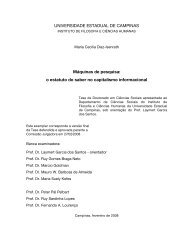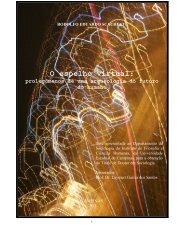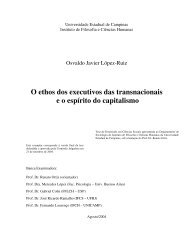As serpentes e o bastão: tecnociência, neoliberalismo e ... - CTeMe
As serpentes e o bastão: tecnociência, neoliberalismo e ... - CTeMe
As serpentes e o bastão: tecnociência, neoliberalismo e ... - CTeMe
Create successful ePaper yourself
Turn your PDF publications into a flip-book with our unique Google optimized e-Paper software.
this work. Historians will consider this a turning point. Researchers in a few years will have trouble imagining<br />
how we studied human biology without the genome sequence in front of us.<br />
I particularly welcome the opportunity to celebrate this moment jointly with our scientific colleagues at Celera<br />
Genomics. And I wish to express my personal gratitude to Dr. Craig Venter for his openness and the cooperative<br />
planning process that led to this joint announcement. I congratulate him and his team on the work done at Celera,<br />
which uses an elegant and innovative strategy that is highly complementary to the approach taken by the public<br />
project. Much will be learned from a comparison of the two. I am happy that today the only race we are talking<br />
about is the human race.<br />
(APPLAUSE)<br />
It is now my distinct pleasure to introduce to you Dr. J. Craig Venter, the president of Celera Genomics.<br />
Inspired by a life-changing experience as a medical corpsman in Vietnam, Craig charged into the field of human<br />
biology with remarkable energy and determination. Never satisfied with the status quo, always seeking new<br />
technology, inventing new approaches when the old ones wouldn't do, he has made profound contributions to the<br />
field of genomics.<br />
His development of the expressed sequence tag, or EST approach for sampling the expressed part of the genome,<br />
reduced to practice the notion of considering the human genome as a bounded but ascertainable set of<br />
information. Just a few years later, he electrified the scientific community by publishing, with his colleague<br />
Hamilton Smith, the complete sequence of a free living organism, the bacterium hemophilus influenzae.<br />
And just three months ago, using the innovative whole genome shotgun approach he developed and working<br />
with Jerry Rubin of the University of California at Berkeley, he and his colleagues published the sequence of the<br />
fruit fly drosophila, another remarkable milestone in biology. Articulate, provocative and never complacent, he<br />
has ushered in a new way of thinking about biology. Now under his leadership, Celera Genomics has<br />
accomplished a remarkable goal: their own first assembly of the human genome sequence. It is an honor and a<br />
pleasure to invite him to tell you about this landmark achievement.<br />
(APPLAUSE)<br />
CRAIG VENTER, PRESIDENT, CELERA GENOMICS: I'm shorter than the previous two speakers.<br />
(LAUGHTER)<br />
Mr. President, Mr. Prime Minister, members of the Cabinet, honorable members of Congress, ambassadors and<br />
distinguished guests, today, June 26 in the year 2000 marks a historic point in the 100,000- year record of<br />
humanity. We are announcing today for the first time our species can read the chemical letters of its genetic<br />
code.<br />
At 12:30 today, at a joint press conference with the public genome effort, Celera Genomics will describe the first<br />
assembly of the human genetic code from whole genome shotgun method.<br />
Starting only nine months ago, on September 8, 1999, 18 miles from the White House, a small team of scientists,<br />
headed by myself, Hamilton Smith, Mark Adams, Gene Myers and Granger Sutton, began sequencing the DNA<br />
of the human genome using a novel method pioneered by essentially the same team five years earlier at the<br />
Institute for Genomic Research.<br />
The method used by Celera has determined the genetic code of five individuals. We have sequenced the genome<br />
of three females and two males who have identified themselves as Hispanic, <strong>As</strong>ian, Caucasian or African-<br />
American.<br />
We did this sampling not in an exclusionary way but out of respect for the diversity that is America and to help<br />
illustrate that the concept of race has no genetic or scientific basis.<br />
In the five Celera genomes, there's no way to tell one ethnicity from another. Society and medicine treats us all<br />
as members of populations whereas individuals, we are all unique, and population statistics do not apply.<br />
I would like to acknowledge and congratulate Francis Collins and our colleagues in the public genome effort in<br />
the U.S., Europe and <strong>As</strong>ia for their tremendous effort in generating a working draft of the human genome. I'd<br />
also like to personally thank Francis for his direct actions in working with me to foster cooperation in the<br />
genome community and to shift our collective focus to this historic moment and its future impact on humanity.<br />
I would also like to thank the president for his commitment to public-private cooperation and for making this day<br />
even more a historic event. Obviously our achievements would not have been possible without the efforts of<br />
thousands of scientists around the world who've gone before us in the quest to better understand life at its most<br />
basic level. The beauty of science is that all important discoveries are made by building on the discoveries of<br />
others. I continue to be inspired by the work of the pioneering men and women in a broad array of disciplines<br />
that have been brought together to enable this great accomplishment.<br />
I would like to particularly acknowledge Charles DeLisi from the Department of Energy and Jim Watson from<br />
Cold Spring Harbor, both here for the vision in helping to initiate the genome project.<br />
372





